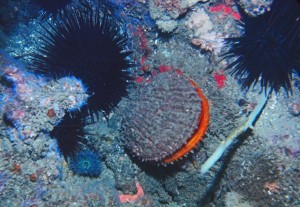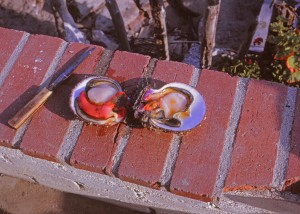 In a blog on November 11, 2011, I discussed the location of the wreck of the Star of Scotland in the middle of Santa Monica Bay, and that blog can be referenced along with other past blogs of interest for the information they contain. One thing I didn’t emphasize at that time is that this a great place to find rock scallops. They grow in abundance all over the wreck, and you can almost count on taking a limit of these tasty creatures. The size varies with how many divers have been visiting the wreck recently, but usually you’ll be happy with your catch.
In a blog on November 11, 2011, I discussed the location of the wreck of the Star of Scotland in the middle of Santa Monica Bay, and that blog can be referenced along with other past blogs of interest for the information they contain. One thing I didn’t emphasize at that time is that this a great place to find rock scallops. They grow in abundance all over the wreck, and you can almost count on taking a limit of these tasty creatures. The size varies with how many divers have been visiting the wreck recently, but usually you’ll be happy with your catch.
Looking for scallops can be an adventure. It’s easiest if you can spot them before they sense your presence and close up, becoming almost indistinguishable with the landscape. I liken them to orange or black smiles pasted among all the other things growing on the reef or wreck. Once spotted you can use a gloved hand to delineate their size and shape and plan where to insert your iron to pry them loose. Be selective, unless the scallop is at least as big as your fist there won’t be all that much meat inside. Leave the little ones to mature, and then you can collect them when they’re bigger next year. No, I don’t know of any difference between orange- or black-lipped specimens. There may be one, but to me they’re both equally tasty to eat.
The scallops found on wrecks are easier to knock off the encrusted rusty metal plates than they are when more firmly attached to rocky ledges. You can often whack them hard on top with an iron and they’ll drop into your hand. The metal doesn’t seem to affect the taste either, and I’ve often enjoyed frying these guys in butter or chopping them up for a seafood chowder.
 One thing I should mention: If a game warden checks your catch they’ll count each piece of scallop as one animal. You need to be careful if you elect to clean your catch on board. Use a thin bladed knife and slide it into the hole alongside the hinge, scrapping the muscle meat away next to the shell. Then, when the shell opens you can free the other side and you’ll end up with one chunk of meat per scallop. If you cut the muscle in the middle and then scrape it off the shell you’ll end up with two chunks of meat per scallop, and even though you only took a legal limit it will look like you exceeded your quota and you might be cited.
One thing I should mention: If a game warden checks your catch they’ll count each piece of scallop as one animal. You need to be careful if you elect to clean your catch on board. Use a thin bladed knife and slide it into the hole alongside the hinge, scrapping the muscle meat away next to the shell. Then, when the shell opens you can free the other side and you’ll end up with one chunk of meat per scallop. If you cut the muscle in the middle and then scrape it off the shell you’ll end up with two chunks of meat per scallop, and even though you only took a legal limit it will look like you exceeded your quota and you might be cited.
Another interesting phenomenon about collecting scallops here is that when you pry or knock them off you’ll draw a host of hungry scavengers after the worms and other goodies that also drop off. Garibaldi, sand bass, perch, sheepshead, and a variety of rockfish of varying size will suddenly be your friends. All-in-all, it’s always a fun dive, and if you do try it, I’ll bet you like it.
